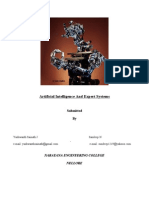IGCSE - PAPER-1 - Student Notes-126-127
IGCSE - PAPER-1 - Student Notes-126-127
Uploaded by
bhingaraarchibold20Copyright:
Available Formats
IGCSE - PAPER-1 - Student Notes-126-127
IGCSE - PAPER-1 - Student Notes-126-127
Uploaded by
bhingaraarchibold20Original Title
Copyright
Available Formats
Share this document
Did you find this document useful?
Is this content inappropriate?
Copyright:
Available Formats
IGCSE - PAPER-1 - Student Notes-126-127
IGCSE - PAPER-1 - Student Notes-126-127
Uploaded by
bhingaraarchibold20Copyright:
Available Formats
Compiled by : Shyam Subrahmanya
6.3 Artificial Intelligence
AI
AI
Artificial Intelligence is a branch of computer science that involves creating computer
systems that can perform tasks that would normally require human intelligence
The goal of AI is to simulate intelligent behaviour in machines, including:
problem-solving, decision-making, natural language processing
AI is often used in areas such as:
Robotics
Natural language processing
Expert systems
Machine learning
Machine learning is a subset of AI that focuses on giving computers the ability to learn and
improve from data, without being explicitly programmed
There are different types of AI, including weak AI, strong AI, and superintelligence
Weak AI, also known as narrow AI, is designed to perform a specific task or set of tasks
Strong AI, also known as artificial general intelligence (AGI), is designed to perform any
intellectual task that a human can do
Superintelligence is a hypothetical AI that would surpass human intelligence in all areas
AI has advantages such as increased efficiency, accuracy, and scalability
However, AI also has disadvantages such as the potential for job loss, biassed decision-
making, and ethical concerns around its use
Characteristics
Collection of data and rules
AI systems require large amounts of data to perform tasks
The data is processed using rules or algorithms that enable the system to make
decisions and predictions
Ability to reason
AI systems can use logical reasoning to evaluate information and make decisions
based on that information
Ability to learn and adapt
AI systems can be designed to learn from past experiences and adjust their behaviour
accordingly
iGCSE Computer Science(0478) - Paper-1 126 of 127
Compiled by : Shyam Subrahmanya
Components
There are two main types of AI systems:
Expert Systems:
Have a knowledge base
A database of facts and rules that are used to solve problems and make decisions
Have a rule base
A set of rules or logic that is used to apply the knowledge in the knowledge base to
specific problems
Have an inference engine
A program that applies the rules in the rule base to the facts in the knowledge base to
solve problems
Have an interface
A way for users to interact with the system and provide input
Machine Learning:
The program has the ability to automatically adapt its own processes and/or data
Uses algorithms to analyse data and identify patterns or relationships
The system can learn from the data and improve its performance over time
Can be supervised or unsupervised:
Supervised machine learning uses labelled data to train the system
Unsupervised machine learning uses unlabelled data
iGCSE Computer Science(0478) - Paper-1 127 of 127
You might also like
- Bluesnarfing: Nicholas RinyuDocument7 pagesBluesnarfing: Nicholas Rinyu555STi0% (1)
- COM 423 AI & Expert System - 240903 - 104915Document39 pagesCOM 423 AI & Expert System - 240903 - 104915syunusa1010No ratings yet
- Introduction To Artificial IntelligenceDocument18 pagesIntroduction To Artificial IntelligenceJoan EbordeNo ratings yet
- Artificial Intelligence Suggestions SVKG inDocument78 pagesArtificial Intelligence Suggestions SVKG inlordsircockNo ratings yet
- Research Paper On AIDocument16 pagesResearch Paper On AICradle StarkNo ratings yet
- Introduction To Artificial Intelligence Machine Learning and Data Science in Mechanical EngineeringDocument24 pagesIntroduction To Artificial Intelligence Machine Learning and Data Science in Mechanical EngineeringlawrancedevarajNo ratings yet
- Artificial IntelligenceDocument11 pagesArtificial Intelligencemanasranjanbhadra577No ratings yet
- Artificial IntelligenceDocument2 pagesArtificial Intelligencetoritu7296No ratings yet
- Artificial IntelligenceDocument1 pageArtificial IntelligenceficcsgNo ratings yet
- G6 - Unit 7 - Artificial Intelligence and Machine LearningDocument12 pagesG6 - Unit 7 - Artificial Intelligence and Machine Learningaryamaansingh12No ratings yet
- Artificial IntelligenceDocument20 pagesArtificial IntelligenceSaima RafiqNo ratings yet
- Edpm SbaDocument16 pagesEdpm SbaROYAL GAMING100% (2)
- AIDocument2 pagesAIneetoosha needrooNo ratings yet
- 1 Unit Artificial IntelligenceDocument7 pages1 Unit Artificial Intelligencemudassir mdNo ratings yet
- AI PresentationDocument14 pagesAI PresentationMuhammad AyaanNo ratings yet
- Narrow AIDocument2 pagesNarrow AIken047447No ratings yet
- Unit 1: Types of AI Based On CapabilitesDocument10 pagesUnit 1: Types of AI Based On CapabilitesAbhishek JoshiNo ratings yet
- Artificial IntelligenceDocument8 pagesArtificial Intelligencesaracastic123No ratings yet
- AIML NotesDocument75 pagesAIML Notesnigermauli69No ratings yet
- Chap 6 - AIDocument48 pagesChap 6 - AIall.vantage.pointsNo ratings yet
- AI Artificial IntelligenceDocument14 pagesAI Artificial IntelligenceMuhammad AyaanNo ratings yet
- A. An Overview of Artificial Intelligence Artificial IntelligenceDocument8 pagesA. An Overview of Artificial Intelligence Artificial Intelligencesharen jill monteroNo ratings yet
- AI ML Introduction1ADocument95 pagesAI ML Introduction1Ajiriraymond65No ratings yet
- Artifical Intelligence Vs Expert SystemDocument11 pagesArtifical Intelligence Vs Expert Systemhsn685936No ratings yet
- Term Governance IADocument8 pagesTerm Governance IAJosue FamaNo ratings yet
- Class 9 (AI Notes and Question Updated Syllabus)Document104 pagesClass 9 (AI Notes and Question Updated Syllabus)svverma1982No ratings yet
- Unit IiDocument20 pagesUnit IifunnymonmetsNo ratings yet
- Experiment A Self - StudyDocument4 pagesExperiment A Self - StudyShrutiNo ratings yet
- Arti Cial Intelligence and Machine LearningDocument6 pagesArti Cial Intelligence and Machine Learningnwagwukelechi646No ratings yet
- Artificial IntelligenceDocument7 pagesArtificial IntelligencePruthwik OsirisNo ratings yet
- Artificial Intelligence GlossaryDocument2 pagesArtificial Intelligence GlossaryJohnNo ratings yet
- Aiml AssignmentDocument21 pagesAiml Assignmentruhi thakurNo ratings yet
- Artificial IntelligenceDocument2 pagesArtificial Intelligencesirike2580No ratings yet
- Understanding Emerging TechnologyDocument5 pagesUnderstanding Emerging TechnologyTUTO A FONDNo ratings yet
- The 10 Stages of Artificial IntelligenceDocument7 pagesThe 10 Stages of Artificial IntelligencereemayoungNo ratings yet
- Artificial IntelligenceDocument9 pagesArtificial IntelligenceDavid U. AnyegwuNo ratings yet
- What Is Artificial IntelligenceDocument2 pagesWhat Is Artificial IntelligencesuneducationnedumangadNo ratings yet
- Ai 2Document29 pagesAi 2saadgohar6913No ratings yet
- Ai: Mind or Machine: By: Riya Kamra 2317929Document4 pagesAi: Mind or Machine: By: Riya Kamra 2317929rriyakamraNo ratings yet
- Extra NotesICT and AI ReflectionDocument12 pagesExtra NotesICT and AI ReflectionD wolf's editsNo ratings yet
- Project Report RTT Rohan G ADocument37 pagesProject Report RTT Rohan G AROHAN G ANo ratings yet
- Introduction AIDocument15 pagesIntroduction AIYogesh KareerNo ratings yet
- Artificial Intelligence and MLDocument13 pagesArtificial Intelligence and MLBhomik-116No ratings yet
- What Is Artificial IntelligenceDocument5 pagesWhat Is Artificial IntelligenceRupak SinghNo ratings yet
- Artificial Intelligence Concepts and ApplicationsDocument30 pagesArtificial Intelligence Concepts and ApplicationsAYAAN MOHSINNo ratings yet
- AI Mid Sem AssesmentDocument4 pagesAI Mid Sem AssesmentAiman AfiqNo ratings yet
- Artificial IntelligenceDocument4 pagesArtificial IntelligenceAnand PokharnaNo ratings yet
- Chapter-3 Artificial Intellgence UpdatedDocument33 pagesChapter-3 Artificial Intellgence Updatedhalakeabduba14No ratings yet
- Ai MLDocument25 pagesAi MLOuis SãłNo ratings yet
- Introduction To AIDocument36 pagesIntroduction To AIvajashweta2001No ratings yet
- AI Assignment 1 Q and ADocument11 pagesAI Assignment 1 Q and AChinmay JoshiNo ratings yet
- Group PresentationDocument18 pagesGroup Presentationdestatolessa13No ratings yet
- RDocument2 pagesRalaaali7118No ratings yet
- Artificial Intelligence and AutomationDocument9 pagesArtificial Intelligence and Automationyoposi7233No ratings yet
- Artificial IntelligenceDocument31 pagesArtificial IntelligenceYusra Mohammed MaatugNo ratings yet
- Concept of AI: Artificial IntelligenceDocument5 pagesConcept of AI: Artificial IntelligenceKartik jainNo ratings yet
- KnowledgeDocument31 pagesKnowledgeMohammed JashidNo ratings yet
- Artificial IntelligenceDocument3 pagesArtificial Intelligencek.srikanth ReddyNo ratings yet
- Artificial Intelligence and Machine LearningDocument5 pagesArtificial Intelligence and Machine LearningNashrinNo ratings yet
- Artificial Intelligence and Expert Systems: Narayana Engineering College NelloreDocument10 pagesArtificial Intelligence and Expert Systems: Narayana Engineering College NelloreGirish ChowdaryNo ratings yet
- AI in Action: A Comprehensive Guide to Real-world ApplicationsFrom EverandAI in Action: A Comprehensive Guide to Real-world ApplicationsRating: 3 out of 5 stars3/5 (1)
- Inbound Marketing Certification Study GuideDocument9 pagesInbound Marketing Certification Study GuideYash TiwariNo ratings yet
- CERTS4THQUARTERDocument8 pagesCERTS4THQUARTERLuivic LapitanNo ratings yet
- Communication Essay 2Document8 pagesCommunication Essay 2api-2839467280% (1)
- Economics Undergraduate Thesis TopicsDocument6 pagesEconomics Undergraduate Thesis TopicsSharon Collins100% (2)
- Bird Talk WorksheetDocument5 pagesBird Talk WorksheetVikram Tukaram Gandhale PRTNo ratings yet
- Mapeh Module 2Document39 pagesMapeh Module 2Elaica Nicole MalekchanNo ratings yet
- HSEDocument308 pagesHSEAnonymous 2JNPJ2aXNo ratings yet
- Math 8 SLHT, q3, Wk8 M8ge-Iiii-J-1Document5 pagesMath 8 SLHT, q3, Wk8 M8ge-Iiii-J-1Zia Belle Bedro - LuardoNo ratings yet
- 584-MBA-2-Human Resource ManagementDocument29 pages584-MBA-2-Human Resource Managementscholars of islamNo ratings yet
- Imci Rec Form FinalDocument1 pageImci Rec Form FinalHecia Gaga-aNo ratings yet
- Lesson 12 Vowel Pattern (A-E, Ay) PDFDocument3 pagesLesson 12 Vowel Pattern (A-E, Ay) PDFIrina MargineanuNo ratings yet
- Competitiveness - Quality and Innovation - PPT - MARYLOU L. TALOSDocument22 pagesCompetitiveness - Quality and Innovation - PPT - MARYLOU L. TALOSAi LeenNo ratings yet
- WIYCR Analysis SlidesDocument24 pagesWIYCR Analysis SlidesRachel HuangNo ratings yet
- PIDE, Internship Report FormatDocument7 pagesPIDE, Internship Report FormatMalik YasirNo ratings yet
- 589 Reading Comprehension Passage 19 MCQ Test With Answers Two Great TraditionsDocument3 pages589 Reading Comprehension Passage 19 MCQ Test With Answers Two Great TraditionsDalga ÖzalNo ratings yet
- Thesis ProposalDocument34 pagesThesis ProposalDeva Persikmania ManchunianNo ratings yet
- Program Results 2019 2023Document189 pagesProgram Results 2019 2023Rohit VishwanathNo ratings yet
- IPDC - 3160003 - PPT Topic - 2023 - 2024Document3 pagesIPDC - 3160003 - PPT Topic - 2023 - 2024JENIL PATELNo ratings yet
- B Ed. ECE and Other New Programmes in Pipeline at SUZADocument2 pagesB Ed. ECE and Other New Programmes in Pipeline at SUZAMuhidin Issa MichuziNo ratings yet
- Teens 3 - Final Oral TestDocument4 pagesTeens 3 - Final Oral Testnascimentocardosoartur79No ratings yet
- Speaking UnpluggedDocument44 pagesSpeaking UnpluggedC2024No ratings yet
- The Impact Of-Covid 19 Pandemic On The Academic Performance of Online Learning Students in Ismael Mathay Sr. High School During The School Year 2020-2021Document12 pagesThe Impact Of-Covid 19 Pandemic On The Academic Performance of Online Learning Students in Ismael Mathay Sr. High School During The School Year 2020-2021Jenalyn Bugaay100% (1)
- Radhika Ravi - ProfileDocument2 pagesRadhika Ravi - ProfilethamaraibalaNo ratings yet
- Types of Organizational StructureDocument17 pagesTypes of Organizational StructuremalaikaNo ratings yet
- (Machado & Silva, 2007) Toward A Richer View of The Scientific Method PDFDocument11 pages(Machado & Silva, 2007) Toward A Richer View of The Scientific Method PDFDesmond HumeNo ratings yet
- Monitoring and Evaluation ToolsDocument39 pagesMonitoring and Evaluation ToolsHening Tirta KusumawardaniNo ratings yet
- Who I AmDocument1 pageWho I AmTarik SulicNo ratings yet
- 17 Training CalendarDocument4 pages17 Training CalendarVijay GaikwadNo ratings yet
- CNF - Consolidated TestDocument3 pagesCNF - Consolidated Testkaren joy baerNo ratings yet

























































































